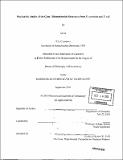| dc.contributor.advisor | JoAnne Stubbe. | en_US |
| dc.contributor.author | Ge, Jie, 1976- | en_US |
| dc.contributor.other | Massachusetts Institute of Technology. Dept. of Chemistry. | en_US |
| dc.date.accessioned | 2005-09-16T20:43:46Z | |
| dc.date.available | 2005-09-16T20:43:46Z | |
| dc.date.copyright | 2003 | en_US |
| dc.date.issued | 2003 | en_US |
| dc.identifier.uri | http://hdl.handle.net/1721.1/27372 | |
| dc.description | Thesis (Ph. D.)--Massachusetts Institute of Technology, Dept. of Chemistry, 2003. | en_US |
| dc.description | Includes bibliographical references. | en_US |
| dc.description.abstract | (cont.) The results of initial studies on the energetics of heterodimer formation using calorimetric techniques and site-directed mutagenesis are discussed in the context of the structures of Y2Y2, Y2Y4, and Y4Y4. As the discovery of a second R2 subunit is not unique to S. cerevisiae, the potential implication of the heterodimer in the regulation of deoxyribonucleotide synthesis is also considered. In the second part of this thesis, pre-steady state kinetics of the class I E. coli RNR is investigated using stopped-flow UV-visible spectroscopy and rapid chemical quench methods. These studies have led to a model in which the rate determining step in catalysis is a physical step prior to proton-coupled electron transfer (PCET), nucleotide reduction, and reverse PCET. These results provide a crucial first step in understanding radical initiation over 35 [angstroms]. | en_US |
| dc.description.abstract | Ribonucleotide reductases (RNRs) catalyze the reduction of ribonucleotides to deoxyribonucleotides, supplying all the monomeric precursors required for DNA replication and repair. The class I enzymes are found in many bacteria, DNA viruses, and all eukaryotes including humans and yeast. This class of RNRs contains two subunits, R1 and R2, and use a tyrosyl radical (Y·) adjacent to a diferric cluster located on R2 as the initiator of radical-based nucleotide reduction chemistry, which takes place on RI. The assembly of the diferric-Y· cofactor in vitro from apo protein, Fe²⁺ 0₂, and reductant has been extensively studied using the prototypical E. coli R2. To understand the mechanism of cofactor assembly in vivo, the source and mechanism of delivery of the required iron and reducing equivalent, S. cerevisiae has been chosen as the ideal model system. The first part of this thesis describes cloning of the four genes encoding the S. cerevisiae RNR subunits. RNRJ and RNR3 encode the large subunit Yl and Y3 (homologous to R1), whereas RNR2 and RNR4 encode the small subunit Y2 and Y4 (homologous to R2). All four genes have been expressed in E. coli, and RNR1 and RNR2 in yeast. Each subunit has been purified to homogeneity. As isolated, recombinant Y2 and Y4, both homodimeric, contain neither the di-iron cluster or the Y·, and hence are inactive. Efforts to generate the diferric-Y· cofactor in vitro led to the interesting discovery that Y· generation is dependent on the formation of a heterodimer between Y2 and Y4. In vitro assembly experiments resulted in the generation of 0.7 eq. of Y· per heterodimer, which is active in nucleotide reduction. | en_US |
| dc.format.extent | 423 p. | en_US |
| dc.format.extent | 37729476 bytes | |
| dc.format.extent | 37729232 bytes | |
| dc.format.mimetype | application/pdf | |
| dc.format.mimetype | application/pdf | |
| dc.language.iso | en_US | |
| dc.publisher | Massachusetts Institute of Technology | en_US |
| dc.rights | M.I.T. theses are protected by copyright. They may be viewed from this source for any purpose, but reproduction or distribution in any format is prohibited without written permission. See provided URL for inquiries about permission. | en_US |
| dc.rights.uri | http://dspace.mit.edu/handle/1721.1/7582 | |
| dc.subject | Chemistry. | en_US |
| dc.title | Mechanistic studies of the class I ribonucleotide reductases from S. cerevisiae and E. coli. | en_US |
| dc.type | Thesis | en_US |
| dc.description.degree | Ph.D. | en_US |
| dc.contributor.department | Massachusetts Institute of Technology. Department of Chemistry | |
| dc.identifier.oclc | 55029308 | en_US |
